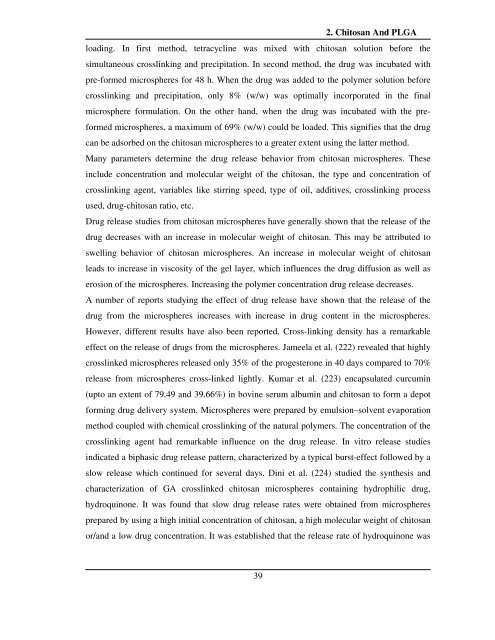chitosan and plga microspheres as drug delivery ... - UniCA Eprints
chitosan and plga microspheres as drug delivery ... - UniCA Eprints
chitosan and plga microspheres as drug delivery ... - UniCA Eprints
You also want an ePaper? Increase the reach of your titles
YUMPU automatically turns print PDFs into web optimized ePapers that Google loves.
2. Chitosan And PLGAloading. In first method, tetracycline w<strong>as</strong> mixed with <strong>chitosan</strong> solution before thesimultaneous crosslinking <strong>and</strong> precipitation. In second method, the <strong>drug</strong> w<strong>as</strong> incubated withpre-formed <strong>microspheres</strong> for 48 h. When the <strong>drug</strong> w<strong>as</strong> added to the polymer solution beforecrosslinking <strong>and</strong> precipitation, only 8% (w/w) w<strong>as</strong> optimally incorporated in the finalmicrosphere formulation. On the other h<strong>and</strong>, when the <strong>drug</strong> w<strong>as</strong> incubated with the preformed<strong>microspheres</strong>, a maximum of 69% (w/w) could be loaded. This signifies that the <strong>drug</strong>can be adsorbed on the <strong>chitosan</strong> <strong>microspheres</strong> to a greater extent using the latter method.Many parameters determine the <strong>drug</strong> rele<strong>as</strong>e behavior from <strong>chitosan</strong> <strong>microspheres</strong>. Theseinclude concentration <strong>and</strong> molecular weight of the <strong>chitosan</strong>, the type <strong>and</strong> concentration ofcrosslinking agent, variables like stirring speed, type of oil, additives, crosslinking processused, <strong>drug</strong>-<strong>chitosan</strong> ratio, etc.Drug rele<strong>as</strong>e studies from <strong>chitosan</strong> <strong>microspheres</strong> have generally shown that the rele<strong>as</strong>e of the<strong>drug</strong> decre<strong>as</strong>es with an incre<strong>as</strong>e in molecular weight of <strong>chitosan</strong>. This may be attributed toswelling behavior of <strong>chitosan</strong> <strong>microspheres</strong>. An incre<strong>as</strong>e in molecular weight of <strong>chitosan</strong>leads to incre<strong>as</strong>e in viscosity of the gel layer, which influences the <strong>drug</strong> diffusion <strong>as</strong> well <strong>as</strong>erosion of the <strong>microspheres</strong>. Incre<strong>as</strong>ing the polymer concentration <strong>drug</strong> rele<strong>as</strong>e decre<strong>as</strong>es.A number of reports studying the effect of <strong>drug</strong> rele<strong>as</strong>e have shown that the rele<strong>as</strong>e of the<strong>drug</strong> from the <strong>microspheres</strong> incre<strong>as</strong>es with incre<strong>as</strong>e in <strong>drug</strong> content in the <strong>microspheres</strong>.However, different results have also been reported. Cross-linking density h<strong>as</strong> a remarkableeffect on the rele<strong>as</strong>e of <strong>drug</strong>s from the <strong>microspheres</strong>. Jameela et al. (222) revealed that highlycrosslinked <strong>microspheres</strong> rele<strong>as</strong>ed only 35% of the progesterone in 40 days compared to 70%rele<strong>as</strong>e from <strong>microspheres</strong> cross-linked lightly. Kumar et al. (223) encapsulated curcumin(upto an extent of 79.49 <strong>and</strong> 39.66%) in bovine serum albumin <strong>and</strong> <strong>chitosan</strong> to form a depotforming <strong>drug</strong> <strong>delivery</strong> system. Microspheres were prepared by emulsion–solvent evaporationmethod coupled with chemical crosslinking of the natural polymers. The concentration of thecrosslinking agent had remarkable influence on the <strong>drug</strong> rele<strong>as</strong>e. In vitro rele<strong>as</strong>e studiesindicated a biph<strong>as</strong>ic <strong>drug</strong> rele<strong>as</strong>e pattern, characterized by a typical burst-effect followed by <strong>as</strong>low rele<strong>as</strong>e which continued for several days. Dini et al. (224) studied the synthesis <strong>and</strong>characterization of GA crosslinked <strong>chitosan</strong> <strong>microspheres</strong> containing hydrophilic <strong>drug</strong>,hydroquinone. It w<strong>as</strong> found that slow <strong>drug</strong> rele<strong>as</strong>e rates were obtained from <strong>microspheres</strong>prepared by using a high initial concentration of <strong>chitosan</strong>, a high molecular weight of <strong>chitosan</strong>or/<strong>and</strong> a low <strong>drug</strong> concentration. It w<strong>as</strong> established that the rele<strong>as</strong>e rate of hydroquinone w<strong>as</strong>39
















